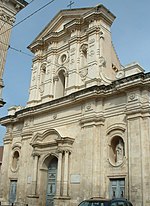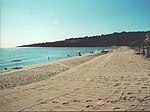Santissima Trinità e San Marziano, Lentini
18th-century Roman Catholic church buildings in ItalyRoman Catholic churches in Lentini

The Chiesa of Santissima Trinità e San Marziano (Church of the Holiest Trinity and St Marziano) is a Roman Catholic church located on via San Francesco d'Assisi, 3, just south of the town centre of Lentini, province of Syracuse, Sicily, Italy.
Excerpt from the Wikipedia article Santissima Trinità e San Marziano, Lentini (License: CC BY-SA 3.0, Authors, Images).Santissima Trinità e San Marziano, Lentini
Via San Francesco d'Assisi,
Geographical coordinates (GPS) Address Nearby Places Show on map
Geographical coordinates (GPS)
| Latitude | Longitude |
|---|---|
| N 37.28275 ° | E 14.99677 ° |
Address
Chiesa della Santissima Trinità e San Marziano
Via San Francesco d'Assisi
96016
Sicily, Italy
Open on Google Maps










